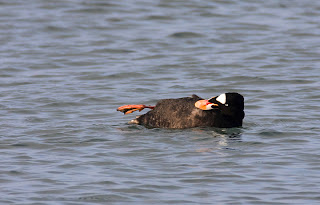I would like to congratulate the top three winners of the Assateague Island Biodiversity Quiz. 1st place is a tie between Marshall Iliff and Matt Hafner who scored a whopping 38. 2nd place goes to Mikey Lutmerding who scored a close 37. Well done!
Thanks to everyone who participated. Here are the answers to the Assateague Biogeography quiz, many of which might be surprising!
1. Tufted Titmouse - Rare/Absent
One of a suite of woodland residents that is very rare on the island: Tufted Titmouse, White-breasted Nuthatch, Hairy Woodpecker, Pileated Woodpecker, and Red-shouldered Hawk.
Consider the differences in habitat, including food sources, cover, and of course nesting challenges.
2. Spring Peeper - Absent
Not recorded on Maryland's barrier islands.
3. Downy Woodpecker - Regular
Common resident.
4. Eastern Gray Squirrel - Rare/Absent
We know of just one sight record in recent history, but perhaps there is a pocket somewhere remote on the island.
5. Eastern Cottontail - Regular. Common.
6. White-tailed Deer - Regular. Common.
7. Pileated Woodpecker - Rare/Absent
One of a suite of woodland residents that is very rare on the island: Tufted
Titmouse, White-breasted Nuthatch, Hairy Woodpecker, Pileated
Woodpecker, and Red-shouldered Hawk.
8. Red Fox - Regular. Common. Predator of endangered beach nesting species.
9. Yellow Warbler - Regular. Common breeder.
10. Yellow-throated Vireo - Rare
Very rarely detected migrant on the island. Many serious Worcester birders lack records. The odd migrant sneaks through in May and September.
11. Bobolink - Regular
A regular spring migrant and fall migrant. Occasionally abundant, especially when hundreds of *bink* calls are detected overhead in nocturnal migration.
12. Rough Green Snake - Regular. An impressive pioneer of island habitats.
13. Cliff Swallow - Rare
A very local breeder on the Eastern Shore and a very rare migrant on the coast.
14. American Toad - Absent
Absent from the barrier islands. Fowler's Toads are abundant, supporting a population of toad-loving Eastern Hog-nosed Snakes.
15. Eastern Chipmunk - Absent
Very local on the Eastern Shore, favoring woodlands like Tuckahoe and Millington.
16. Northern Saw-whet Owl - Regular
Regular migrant and wintering species.17. Hairy Woodpecker - Rare/Absent
One of a suite of woodland residents that is very rare on the island: Tufted
Titmouse, White-breasted Nuthatch, Hairy Woodpecker, Pileated
Woodpecker, and Red-shouldered Hawk.
18. Cape May Warbler - Regular
Uncommon spring migrant and common fall migrant. Occasional major fall flights, especially in October.
20. House Wren - Regular
Common migrant and breeder. Often lingers into winter in small numbers
21. White-breasted Nuthatch - Rare
A very rare migrant on the island and in Ocean City.One of a suite of woodland residents that is very rare on the island.
22. Eastern Box Turtle - Regular
Jim Brighton and I have about 5 records for Assateague between us.
23. Cooper's Hawk - Regular
24. Red-shouldered Hawk - Rare migrant/wintering species. Records concentrated in January/February, it seems.
25. Merlin - Regular
Common migrant and wintering species here.
26. Mute Swan - Rare
Only a handful of reports for the county in the last few years. Very unpredictable appearances and many serious Worcester birders need it.
27. Red-breasted Merganser - Regular
Very common migrant/wintering species.
28. Red-backed Salamander - Absent
Absent from the Maryland barrier islands.
29. Wood Turtle - Absent
Nearly absent from the Eastern Shore of Maryland.
30. Common Merganser - Rare
Local on the Eastern Shore, mostly on the upper Eastern Shore and Blackwater area. Rare anywhere in Worcester and especially so on the immediate coast.
31. Surf Scoter - Regular
Common to abundant migrant and wintering species.
32. Eastern Screech-Owl - Rare
Common in coastal Worcester, but very rarely encountered on the island.
33. Louisiana Waterthrush - Rare
Very rarely detected as a migrant anywhere in Maryland, really, but especially rare on the immediate coast. Jim, John Hubbell and I had our one migrant on the island was 8/9/2009.
Perhaps more effort at the very first stirrings of "fall" migration would result in a few more records.
34. Eastern Kingbird - Regular
Common migrant and breeder. Vast majority gone by October.
35. Chipping Sparrow - Regular. Common.
36. American Tree Sparrow - Rare
Uncommon on the Coastal Plain and rarer as you head east and south on the Eastern Shore. Very rare winter visitor to the island. A mini-irruption in February 2010 provided some rare records, most of our county birds.
37. Pine Warbler - Regular
38. Delmarva Fox Squirrel - Rare/Absent
We personally know of no recent records in the Maryland section of the island, but present on the Virginia side. Possibly present in remote patches.
39. Painted Bunting - Rare
One record? 9/5/2003
40. Eastern Whip-poor-will - Rare
Or at least very difficult to detect! Chuck-will's-widow is common.
I would like to thank Bill Hubick for creating a great post and supplying the wonderful photographs. More of Bill's photography can be viewed at www.billhubick.com. Once again, both Bill and I would like to thank everyone who participated.











Nice quiz...though one could argue that plants and insects should have been included in a biodiversity quiz...
ReplyDeleteI'll make a deal with you Sam. If you write a guest post for my blog on how to identify our native bumblebees, I'll be sure that Bill includes plants and insects in his next guest post biodiversity quiz :)
ReplyDeleteSam, we agree and seriously considered it! Though as you know it's dangerous to move people too rapidly from a birds-only naturalist diet. You have to wean people off of it! From American Coppers to Oblique-lined Tiger Beetles and Yellow Thistle, though, don't worry - we keep our Assateague lists! (Though admittedly many of us could invest more into learning some groups, such as bees. We need more identification keys!)
ReplyDelete